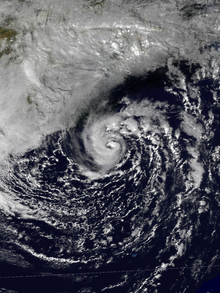 The unnamed hurricane at peak intensity on November 1 | |
| Meteorological history | |
|---|---|
| Formed | October 28, 1991 (Extratropical until October 31) |
| Dissipated | November 2, 1991 |
| Category 1 hurricane | |
| 1-minute sustained (SSHWS/NWS) | |
| Highest winds | 75 mph (120 km/h) |
| Lowest pressure | 980 mbar (hPa); 28.94 inHg (972 mbar (28.7 inHg) while extratropical) |
| Overall effects | |
| Fatalities | 13 direct |
| Damage | >$200 million (1991 USD) |
| Areas affected | Mid-Atlantic states, Northeastern United States, Eastern Canada |
| IBTrACS | |
Part of the 1991 Atlantic hurricane season | |
The 1991 Perfect Storm, also known as The No-Name Storm (especially in the years immediately after it took place)[1] and the Halloween Gale/Storm, was a damaging and deadly nor'easter in October 1991. Initially an extratropical cyclone, the storm absorbed Hurricane Grace to its south and evolved into a small unnamed hurricane later in its life. Damage from the storm totaled over $200 million (1991 USD)[2] and thirteen people were killed in total, six of which were an outcome of the sinking of Andrea Gail, which inspired the book and later movie, The Perfect Storm. The nor'easter received the name, playing off the common expression, after a conversation between Boston National Weather Service forecaster Robert Case and author Sebastian Junger.
The initial area of low pressure developed off the coast of Atlantic Canada on October 28. Forced southward by a ridge to its north, it reached its peak intensity as a large and powerful cyclone. The storm lashed the east coast of the United States with high waves and coastal flooding before turning to the southwest and weakening. Moving over warmer waters, the system transitioned into a subtropical cyclone before becoming a tropical storm. It executed a loop off the Mid-Atlantic states and turned toward the northeast. On November 1, the system evolved into a full-fledged hurricane, with peak sustained winds of 75 miles per hour (120 km/h), although the National Hurricane Center left it unnamed to avoid confusion amid media interest in the precursor extratropical storm. The system was the twelfth and final tropical cyclone, the eighth tropical storm, and fourth hurricane in the 1991 Atlantic hurricane season. The tropical system weakened, striking Nova Scotia as a tropical storm before dissipating.
Most of the damage occurred while the storm was extratropical, after waves up to 30 feet (10 m) struck the coastline from Nova Scotia to Florida and southeastward to Puerto Rico. In portions of New England, the damage was worse than that caused by Hurricane Bob two months earlier. Aside from tidal flooding along rivers, the storm's effects were primarily concentrated along the coast. A buoy off the coast of Nova Scotia reported a wave height of 100.7 feet (30.7 m), the highest ever recorded in the province's offshore waters. In Massachusetts, where damage was heaviest, over 100 homes were destroyed or severely damaged. To the north, more than 100 homes were affected in Maine, including the vacation home of then-President George H. W. Bush. More than 38,000 people were left without power, and along the coast high waves inundated roads and buildings. Off the shore of New York's Long Island, an Air National Guard helicopter ran out of fuel and crashed; four members of its crew were rescued and one died. Two people died after their boat sank off Staten Island. High waves swept two people to their deaths, one in Rhode Island and one in Puerto Rico, and another person was blown off a bridge to his death. The tropical cyclone that formed late in the storm's duration caused little impact, limited to power outages and slick roads; one person was killed in Newfoundland from a traffic accident related to the storm.
- ^ Beegel, Susan F. "Journal of the No-Name Storm". Nantucket Historical Association. Retrieved January 18, 2023.
- ^ McCown, Sam (August 20, 2008). ""Perfect Storm" Damage Summary" (PDF). National Climatic Data Center. National Oceanic and Atmospheric Administration. Archived from the original (PDF) on September 6, 2021. Retrieved April 5, 2019.